
There's not a lot of depth in Rage's bone-dry wasteland, but there's plenty of variety. Coming from id Software, the company that's brought you two decades' worth of first-person shooter after straight-ahead first-person shooter, that's worth noting. The core shooting in Rage isn't especially original, but it is highly entertaining, and the shooting intermingles with arcade-style racing action and a thin layer of quasi-role-playing hooks to give you plenty to do in between the main story levels. This is meat-and-potatoes action game design with a few antiquated quirks, but it does what it does well enough--and looks legitimately stunning while doing it--to deliver a satisfying experience, all told.
It's impossible not to compare Rage to Fallout 3, not least because both games share the same publisher. But either way, the premise here is awfully familiar: Just prior to a global catastrophe, humanity buries a few lucky survivors in underground capsules, to emerge some time later and rebuild society. Sound familiar? Credit at least goes to id for coming up with an original apocalypse, in this case the real-life asteroid Apophis that may actually strike the Earth in 2036. A century after the asteroid strike, you're a cybernetically enhanced member of that program who emerges to find a world that's been rebuilt out of scrap and duct tape, with various bandit clans controlling different parts of the wasteland, a few good-hearted folks trying to eke out a hard-scrabble existence in between, and a cliched, mechanized regime keeping oppressive watch over the whole thing.
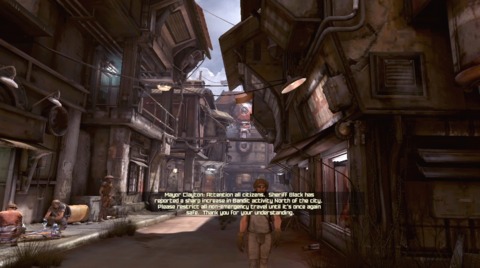
There's room even in a familiar premise like this to explore new dramatic ideas, but Rage plays it as straight as possible with its story elements. Every character wears his or her intentions on their sleeves, and there's only one minor wrinkle in the plot that seems like it might go somewhere interesting, but then only seems to set up a potential sequel. The voice cast, featuring John Goodman leading a legion of familiar-sounding voiceover pros, at least does an admirable job bringing character to the people you interact with, and even if the things they're saying are usually bare justification to get you to the next action stage, it's at least a joy to watch them say it. Every line of dialogue in the game has a unique animation routine attached to it; the characters gesticulate and emote with the kind of detail that suggests a bunch of animators poring over every dialogue recording and mimicking the final output in a mirror to get those subtle human movements just right. Oddly enough, that detail actually goes a long way toward bringing the world to life and drawing you in. It's a minor point, but it also helps that the small number of characters in each friendly town have a habit of moving around a lot between missions. You don't really notice how odd it is that most video game characters stand in the exact same spot for the duration of an entire game until you see them break free and actually go stand in a different place once in a while.
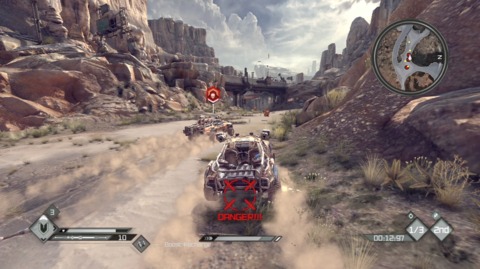
Anyway, aside from the initial setup, Rage is not Fallout. In fact, it's almost Fallout's direct opposite, strong in the areas where Fallout falters--fast action, lush visuals--and weak at doing what Fallout does well, which is character customization, exploration, and storytelling. You get the first hint of this the second you step out of your capsule and into the wasteland. Remember exiting Vault 101 and slowly panning across the vast landscape, and all the potential for adventure it held? Here, you're not outside 30 seconds before John Goodman is shooting a mutant off of you and yelling at you to get in his buggy so he can whisk you away to your first proper mission. The game takes a similarly fast-paced, streamlined approach to the weapon lineup (essentially the same one you've come to expect from all id games) and the crafting and looting, which respectively have you building useful combat items out of the component parts that are useful, and selling all the junk that isn't. It's not a bad thing these systems are so simplified, it's just the focus of the game to keep things moving expediently from one action sequence to the next without leaving you bogged down in menus.
Nearly all of id's games have just been shooters--run forward, blast everything that gets in your way, repeat in next level--and that sequence of events still forms the backbone of Rage. But instead of merely presenting a linear chain of levels joined end to end with loading screens, those levels are now connected more dynamically with a wasteland hub environment that you traverse in your Mad Max-style dilapidated vehicles. In between the story levels--which still roll out in one specific order--you can do some quick circuit races to earn upgrades for your cars, pick up some mercenary jobs from a bulletin board, or play a diverse little assortment of cash-generating minigames that includes a surprisingly complex, Magic: The Gathering-style card battler that ties into cards you collect throughout the game. Out in the wasteland, there's not much to discover outside of the places the main and side missions send you, though there's satisfying combat to be done with the local bandits, and there are a few trick jumps to hit here and there. Many, though not nearly all, of the side missions yield benefits like new item recipes that help flesh out the gameplay a bit.
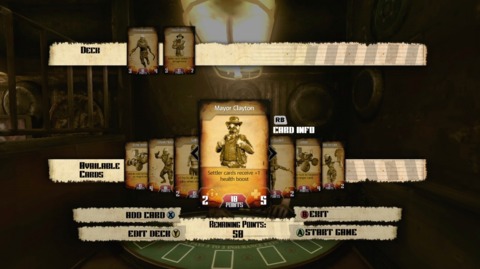
I'm glad these diversionary activities are there, because they're all just entertaining enough to cleanse your palate if you want a break from the shooting missions. But still, shooting stuff is your primary activity, so it's a good thing Rage's combat hits as hard as it does. Par for an id game, all the weapons have a heavy, powerful feel, made a lot more pronounced by the varied, over-the-top ways enemies react to getting hit by them. The game has some of the best ragdoll physics in recent memory; the spindly lesser mutants will flip head over heels from a squarely placed shotgun blast, while the human enemies will believably go flying over a rail or slam face first into a wall if you hit them right. It's all kind of silly, action-movie stuff that probably won't do much for you if you aren't in the mood for a traditional shooter, but if you are, it's immensely satisfying. I got a lot of entertainment value out of the combat since all the weapons have multiple ammo types that are especially effective in specific situations, and engineering items like stationary turrets, a spider robot straight out of Doom 3, and the boomerang-like bladed wingstick give you a lot of options to play with. A lot of thought clearly went into the best interface to manage all of these weapons, ammo types, and gadgets. If I told you that you use both shoulder buttons, both analog sticks, and the d-pad to do so, you'd be justified in thinking it might be unwieldy. But it's actually quick and elegant. Most of the missions ultimately boil down to you shooting your way to the end of a map to hit a switch or pick up an item, but at least getting there is a lot of fun.
It's good at what it does, but Rage isn't without flaws. It lacks a modern checkpoint system, and only creates an auto-save the last time you loaded into a level, meaning you'll replay an entire mission if you die without saving in the middle. You'll probably only get burned by that system once before you learn to start making hard saves frequently, but man is it frustrating when it happens. Some of the enemy groups are also kind of ridiculous. Each clan of bandits is composed of two or three of the exact same guy, and all of them use exactly one voice actor per group, so you get the same silly British or Russian accent coming from a big mass of enemies that all look the same. The game has the sensibilities of a comic book or, you know, a video game, so that's not really worth getting hung up on, but it stood out to me initially.
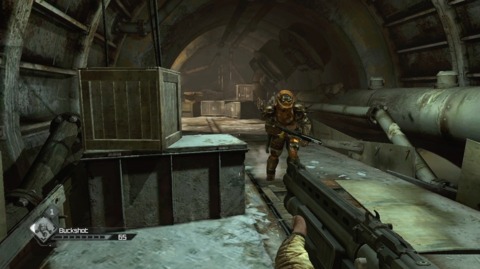
Even if Rage were the worst game to come out in a long while, it would still arguably be the best-looking one. The sheer complexity of texture and detail packed into every one of the game's environments is nothing short of staggering, especially in the two town hubs that you'll return to again and again between missions. The vast richness of the wasteland also can't be overstated. This is one of the best-looking games available on consoles, as good-looking as most any Unreal Engine game, yet it runs at double the frame rate of those games. Seeing a game on aging console hardware that looks this good and runs this smoothly is almost surreal. To be fair, in all three versions, there's a noticeable amount of detailed texture pop-in when you quickly look in different directions, but it's only something you really notice when you look for it and try to make it appear; it doesn't stand out much when you're playing the game like you normally would. Setting that one quirk aside, you really need to see this game in motion, in person, to appreciate just how good it actually looks.
All three versions of the game have some sort of technical quirk, unfortunately. The 360 version looks better than the PS3 one and runs at a rock-solid 60 frames per second, but it ships on three discs and dropped me to the dashboard with an error every time I tried to swap them, requiring me to start the new disc back up and load a save to continue. The one-disc PS3 version suffers from a slightly lower (though still fully acceptable) frame rate at times, and the texture pop-in is slower and thus more prominent there. And, mindbogglingly, the PC version launched in a miserable state that rendered it unplayable on ATI cards, though a matter of hours later an emergency set of drivers seems to have things working fine on both brands of GPU. The PC version is naturally the sharpest one (though I saw an inordinate amount of tearing on our office PC setup), and it plays fine with the good old keyboard and mouse, though it's a testament to how good the console versions look and how well they play on a gamepad that the PC version is only marginally better in general.
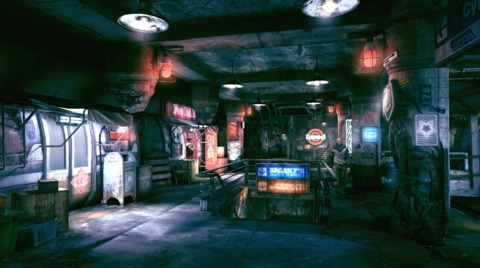
You'll probably spend between 10 and 15 hours on the campaign here if you try to do everything there is to do; I ended up on the high end of that range due to obsessively looking for collectibles and, honestly, gawking repeatedly at how damn pretty everything is. There's also a decent two-player co-op mode that mostly repurposes levels from the story mode but changes the enemy distribution and tries to give the missions some context by couching them in light back story from the main game. (One mission tells how three giant stuffed mutant heads came to adorn the wall of the local watering hole, for instance.) There's also a four-player driving mode with a variety of objectives that lets you rank up and unlock new weapons and better cars. Though I had a good time with the driving combat in the campaign, I didn't have much desire to keep doing it against human players, so I didn't spend much time there. The co-op is a bigger draw, at least until you play through the handful of missions available.
Over the first couple of hours, you may find yourself coming to terms with the style of game Rage actually is, rather than the type of game you may have expected it to be based on some of its peripheral design elements. A deep and sprawling experience it's not, but as a focused, directed shooter with a few other things to do between the shooting, it hits the right notes. And damn does it look good doing it.